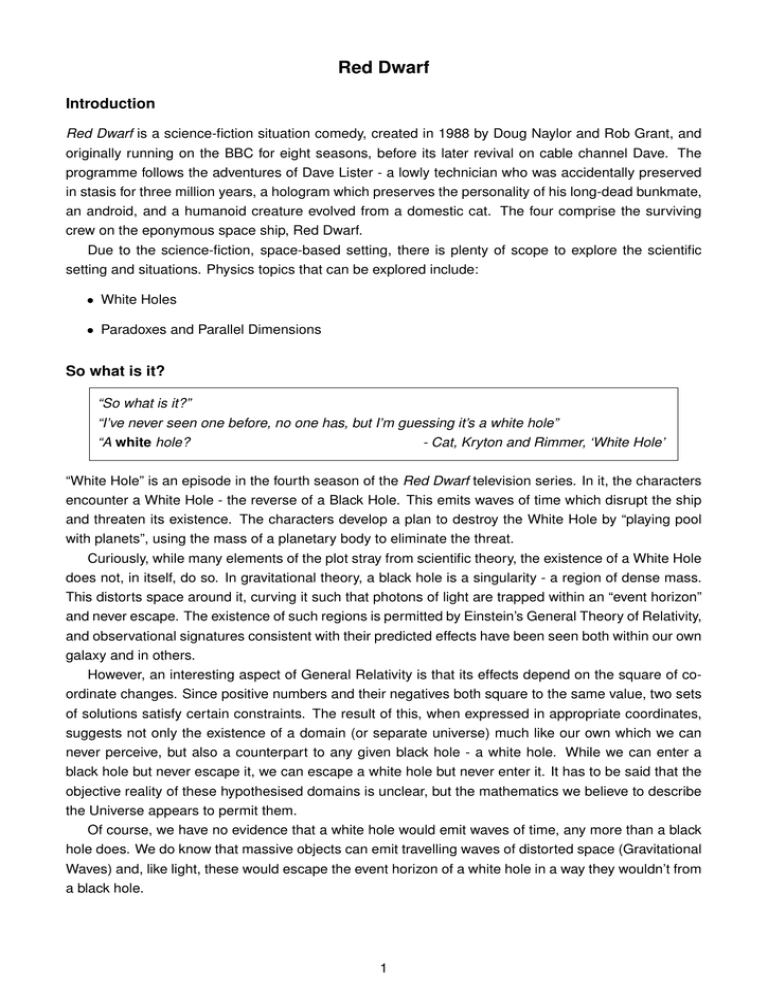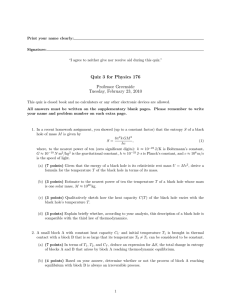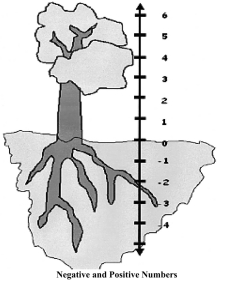Red Dwarf Introduction
advertisement

Red Dwarf Introduction Red Dwarf is a science-fiction situation comedy, created in 1988 by Doug Naylor and Rob Grant, and originally running on the BBC for eight seasons, before its later revival on cable channel Dave. The programme follows the adventures of Dave Lister - a lowly technician who was accidentally preserved in stasis for three million years, a hologram which preserves the personality of his long-dead bunkmate, an android, and a humanoid creature evolved from a domestic cat. The four comprise the surviving crew on the eponymous space ship, Red Dwarf. Due to the science-fiction, space-based setting, there is plenty of scope to explore the scientific setting and situations. Physics topics that can be explored include: • White Holes • Paradoxes and Parallel Dimensions So what is it? “So what is it?” “I’ve never seen one before, no one has, but I’m guessing it’s a white hole” “A white hole? - Cat, Kryton and Rimmer, ‘White Hole’ “White Hole” is an episode in the fourth season of the Red Dwarf television series. In it, the characters encounter a White Hole - the reverse of a Black Hole. This emits waves of time which disrupt the ship and threaten its existence. The characters develop a plan to destroy the White Hole by “playing pool with planets”, using the mass of a planetary body to eliminate the threat. Curiously, while many elements of the plot stray from scientific theory, the existence of a White Hole does not, in itself, do so. In gravitational theory, a black hole is a singularity - a region of dense mass. This distorts space around it, curving it such that photons of light are trapped within an “event horizon” and never escape. The existence of such regions is permitted by Einstein’s General Theory of Relativity, and observational signatures consistent with their predicted effects have been seen both within our own galaxy and in others. However, an interesting aspect of General Relativity is that its effects depend on the square of coordinate changes. Since positive numbers and their negatives both square to the same value, two sets of solutions satisfy certain constraints. The result of this, when expressed in appropriate coordinates, suggests not only the existence of a domain (or separate universe) much like our own which we can never perceive, but also a counterpart to any given black hole - a white hole. While we can enter a black hole but never escape it, we can escape a white hole but never enter it. It has to be said that the objective reality of these hypothesised domains is unclear, but the mathematics we believe to describe the Universe appears to permit them. Of course, we have no evidence that a white hole would emit waves of time, any more than a black hole does. We do know that massive objects can emit travelling waves of distorted space (Gravitational Waves) and, like light, these would escape the event horizon of a white hole in a way they wouldn’t from a black hole. 1 As for “playing pool with planets” - i.e. using weapons fire to force planets out of orbit and into the singularity - well, that makes for an interesting analysis all of its own. Lister decides to play a trick-shot, his weapons fire strikes a planet, which is knocked into a second planet, which in turn knocks a third out of the solar system and twowards the white hole. Interestingly enough this isn’t a bad approach. If a massive planet is knocked into a smaller orbit, its gravitational potential can be exchanged for kinetic energy. This can be transferred to a smaller planet through collision, accelerating it, and then the process repeated until a significant impulse is applied to the inner most, smallest planet, perhaps accelerating it to the local escape velocity and enabling it to reach to black hole. Conserving angular momentum (mr × v) in this scenario might require careful calculation, assuming it is possible, and will depend on the properties of the system. However the biggest problem is the initial shot. Even ignoring the conservation of angular momentum considerations involved in the orbit changes, it’s worth noting that if Starbug’s weapons pack enough punch to knock a planet out of its orbit, the Red Dwarf’s crew’s problems would likely be rather less severe than they often appear! Paradoxes and Parallel Dimensions “Hey, it hasn’t happened, has it? It has ‘will have going to have happened’ happened, but it hasn’t actually ‘happened’ happened yet, actually.” “It will be happened; it shall be going to be happening; it will be was an event that could will have been taken place in the future. Simple as that.” - Lister and Rimmer, ‘Future Echoes’ There are several examples in the series of instances where the central characters encounter time travel or jump between parallel dimensions. Red Dwarf is notable for its handling of paradox - the possibility that changes in the past will change the present in such a way as to prevent the time travel occuring. The first notable example of time travel occurs in the episode “Future Echoes”. In this story, the transition to faster than light travel is accompanied by visual disturbances which appear to show incidents happening in the future. While Lister tries unsuccessfully to prevent a foreseen incident from happening, events seem to be taking him inevitably towards his own foreseen death. Shortly later, in “Stasis Leak” they travel physically back into the past, attempting to ensure others are preserved cryogenically in the same manner as Lister. In “Timeslides” they again travel physically, but only within the confines of a specially treated photograph. In “Out of Time” they encounter a future version of themselves, shortly after discovering a time machine. Finally in “Tikka to Ride” they use a matter transmitter device to return to Earth in the mid twentieth century. While in “Future Echoes” the path of events was deemed immutable, in the remaining episodes, changes are made to the timeline. However, in each case a form of paradox was encountered, and the actions of the Red Dwarf crew resulted in a restoration of the original course of events. In some cases (e.g. “Stasis Leak”) this happened unintentionally, in others (notably “Tikka to Ride” where they 2 arranged for US President John F Kennedy to become his own assassin) the decision to restore the timeline was taken consciously. In at least one case (“Out of Time”) a character made a deliberate decision to induce a paradox, destroying a time machine so as to reverse the actions of the crew’s future selves. This is an extreme example of a so-called “Grandfather Paradox” - first posed in a science fiction novel in the 1940s in which a time traveller accidentally killed his grandfather before his father was conceived. The solution most often proposed to such problems utilises the potential in quantum physics for the existance of parallel universes, distinguished from our own by the probabilistic result of any given measurement. An example of the Many-Worlds interpretation of the Grandfather Paradox In this Many-Worlds theory, first proposed by Hugh Everett and popularised by DeWitt in the 1960s, parallel universes branch from every point in time and every decision made, often differing by infinitesimal factors. The time traveller appears to move backwards along his own timeline, but in fact does not - he is instead transported into a parallel universe he himself creates, in which his actions prevent his own conception, but do not affect his timeline of origin. Most of the time travel incidents in Red Dwarf appear consistent with this model - where changes are made, the characters are unable to return to their point of origin. While causality does occasionally appear to be breached, there are examples of characters fading from existence when this occurs. It is also worth noting that the existence of such parallel universes is an established fact in the Red Dwarf universe - travel between them occurs deliberately in several episodes. While Red Dwarf is certainly consistent with Many-Worlds multiverse theories, these have actually been becoming less popular in recent decades - in part because of the incomprehensible infinity of universes required to satisfy every probability since the start of time. More recently Stephen Hawking has proposed the so-called “chronology protection conjecture” - a statement, albeit one without proof, that the Universe likely does not permit the existence of closed time-like worldlines (i.e. time travel for any observer) and so the situation does not arise. The notable difficulty the crew experience in enacting any significant change to their own history, particularly in the early stages of their adventures, may suggest the action of an intermediate theory: the “Novikov self-consistency principle” states that time travel is possible, but its occurance affects probabilities such that a paradox can never happen. Concluding Thoughts There is not room here to discuss the full range of scientific concepts explored in this comedic science fiction series. Issues such as genetically engineered lifeforms, holograms, artificial intelligence, gestalt sentience, and the perils of unchecked scientific research recur throughout the series, and could usefully be discussed with students. There are also several dramatic sequences involving crashing or exploding craft which could usefully be worked as an exercise in mechanics - not to mention a lightspeed drive. However, it is perhaps the more counter-intuitive, paradoxical and relativistic effects that have the most entertaining consequences, and are discussed here. 3




